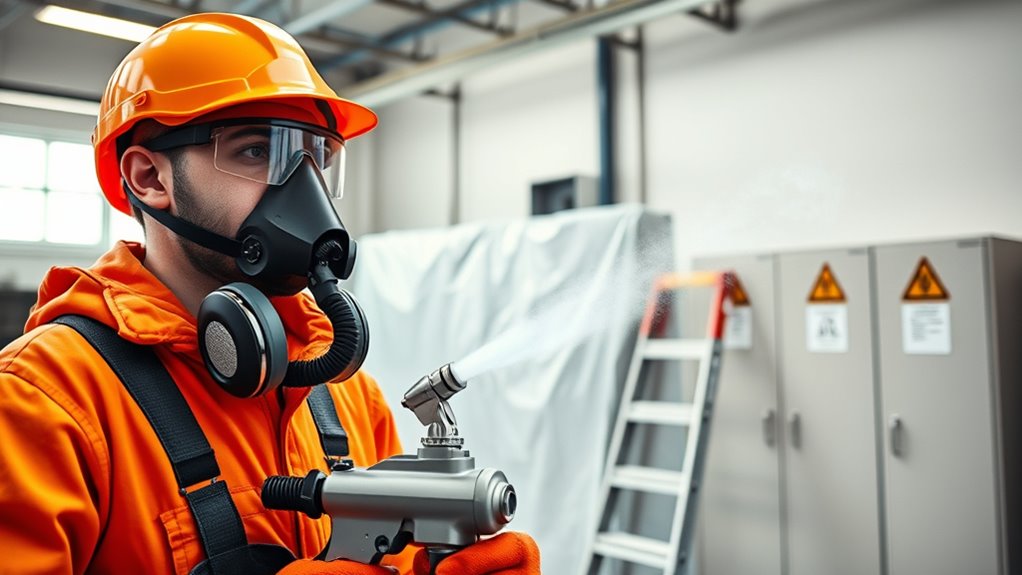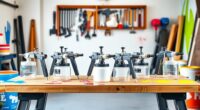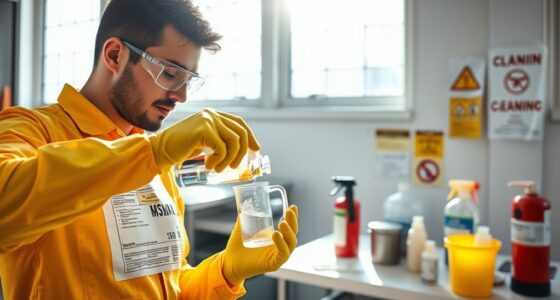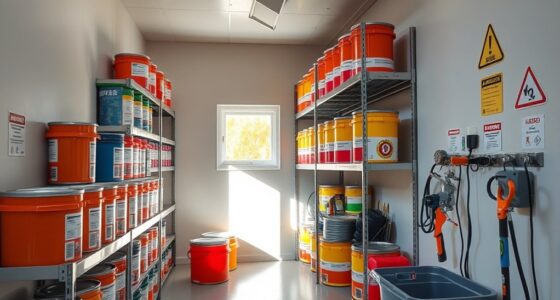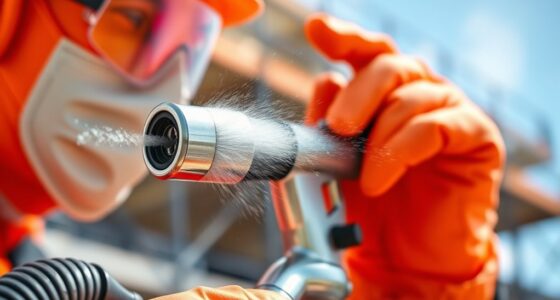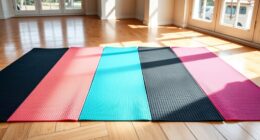When using an airless paint sprayer, always wear protective gear like a respirator, goggles, and chemical-resistant clothing to shield yourself from fumes and overspray. Confirm proper ventilation by opening windows or using exhaust fans to keep fumes away. Regularly inspect and maintain your equipment to prevent leaks or malfunctions, and keep your workspace organized to avoid accidents. For more tips on staying safe, continue exploring the best practices for your project.
Key Takeaways
- Always wear a high-quality respirator or mask to protect against paint fumes and airborne particles.
- Ensure proper ventilation by opening windows, using fans, and installing exhaust systems to disperse fumes.
- Regularly inspect and maintain the sprayer to prevent leaks, malfunctions, and accidental releases of paint or fumes.
- Use goggles or safety glasses, along with protective clothing, to shield eyes and skin from overspray and splashes.
- Keep the workspace organized, secure hoses, and handle paint containers carefully to prevent trips, spills, and injuries.
Essential Safety Measures for Airless Paint Sprayer Use

Using an airless paint sprayer can make your painting project faster and more efficient, but it also comes with safety risks if you don’t take proper precautions. One of the most important steps is wearing the right protective gear. Spray painting releases fine particles and fumes that can be harmful if they come into contact with your skin, eyes, or respiratory system. Always wear a high-quality respirator or mask designed for paint fumes, along with goggles or safety glasses to shield your eyes from overspray. Long sleeves, gloves, and pants made from durable, chemical-resistant materials help protect your skin from accidental splashes and contact with toxic substances. Never skip these safety items, even if you think the task is quick or minor; neglecting protective gear can lead to serious health issues over time. Proper ventilation is equally vital when operating an airless sprayer. Proper ventilation minimizes inhalation of hazardous fumes and helps disperse overspray outside your workspace. If you’re working indoors, open windows and doors wide to create a cross-breeze. Using fans to direct fumes outdoors can further improve air quality. If possible, set up your painting area in a well-ventilated space or outdoors to prevent dangerous fumes from accumulating. For indoor projects, consider installing exhaust fans or using portable air filtration systems to ensure constant airflow. Remember, even if the paint is low in VOCs (volatile organic compounds), good ventilation still reduces fatigue and helps you breathe easier during long sessions. Additionally, always inspect your equipment before starting. Check hoses, nozzles, and seals for leaks or damage. A malfunctioning sprayer can cause unpredictable spray patterns or accidental releases of paint and fumes, increasing safety hazards. Keep your workspace clean and organized to prevent tripping over hoses or knocking over paint containers, which could lead to spills or injuries.
Frequently Asked Questions
What Should I Do if I Get Paint in My Eyes?
If you get paint in your eyes, prioritize eye safety by acting quickly. Immediately rinse your eyes with clean, lukewarm water for at least 15 minutes, keeping your eyelids open. Avoid rubbing your eyes and seek emergency response if irritation persists. Prompt action helps prevent damage, so don’t delay in seeking professional medical care. Remember, quick and proper emergency response is key to protecting your eye health.
How Often Should I Inspect the Spray Gun During Use?
You should inspect the spray gun frequently during use, ideally before starting and at regular intervals, to guarantee proper spray gun maintenance. Regular inspection helps identify any wear, leaks, or clogs that could affect performance or safety. Maintaining a consistent inspection frequency keeps your equipment in top condition, reduces the risk of accidents, and ensures smooth, efficient operation throughout your project. Don’t skip these vital safety steps.
Can I Use an Airless Sprayer Indoors Safely?
You can use an airless sprayer indoors safely if you guarantee proper ventilation and masking. Make sure you open windows and use fans to keep fresh air circulating, reducing fumes. Always wear proper masks to protect yourself from paint particles and fumes. Additionally, cover surfaces and furniture with drop cloths to prevent overspray. Following these precautions helps you work efficiently and safely inside without risking health or damage.
What PPE Is Mandatory for Prolonged Spraying Sessions?
For prolonged spraying sessions, you need to wear essential PPE like protective eyewear to shield your eyes from splatters and respiratory masks to prevent inhaling harmful fumes or overspray. These safety items are mandatory to protect your health during extended use. Always guarantee your respiratory mask fits properly and replace filters regularly. Wearing proper PPE minimizes health risks and keeps you safe throughout your painting project.
How Do I Properly Clean and Store the Sprayer After Use?
To guarantee proper cleaning and safe storage, first disconnect the sprayer from the power source. Flush out remaining paint with the appropriate solvent, then clean all parts thoroughly with a brush or cloth. Once dry, store the sprayer in a clean, dry place away from extreme temperatures. This prevents damage and maintains your equipment’s longevity, making future use safe and efficient.
Conclusion
By mastering these manageable, mindful safety measures, you’ll minimize mishaps and maximize mastery. Remember, safety isn’t just a suggestion—it’s your shield against spills, splatters, and surprises. Stay vigilant, follow the fundamentals, and prioritize protection at every step. With careful caution and confident control, you’ll conquer your project with peace of mind and pride. Protect yourself, prevent problems, and paint with precision—your safety is the ultimate success.
